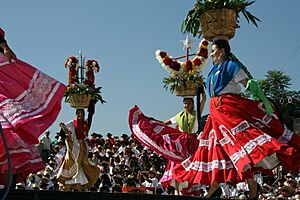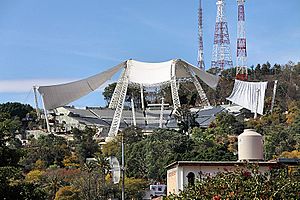Guelaguetza facts for kids
The Guelaguetza [ɡelaˈɣetsa] is a big annual cultural event in Mexico. It's also known as Los lunes del cerro, which means "Mondays on the Hill." This special celebration happens in Oaxaca, the capital of the state of Oaxaca, and in nearby towns.
During Guelaguetza, people wear traditional costumes and perform dances. You can see parades with local music bands, try delicious native foods, and find amazing handmade crafts. Each costume, called a traje, and every dance tells a story about the history and culture of the local people. While many tourists visit, the Guelaguetza is super important for the native people of Oaxaca. It helps keep their unique cultures alive and strong.
Contents
What is Guelaguetza?
Oaxaca has a very large native population. More than 30% of the people in Oaxaca are indigenous, which is much higher than the rest of Mexico. This means that indigenous culture is still very strong here. Hundreds of thousands of people speak their native languages, and many others speak both their native language and Spanish.
Unlike some other states in Mexico, Oaxaca is home to many different indigenous cultures. For example, the Zapotec and Mixtec groups are the largest. But there are many other groups, and each has its own special traditions and languages. The Guelaguetza celebration is a very old tradition. It started long before the Spanish arrived in Mexico. It's a key part of Oaxaca's culture.
The word Guelaguetza comes from the Zapotec language. It means "exchanging gifts and services." This idea of sharing and helping each other is very important in indigenous cultures. The festival originally began as a religious celebration. It honored the earth and the corn god, as corn was a vital crop. Over hundreds of years, the festival also began to include Christian traditions after the Spanish came to Mexico.
Guelaguetza's History
The Guelaguetza is also a way to honor Our Lady of Mount Carmel, a Christian figure. This shows how old traditions mixed with new ones over time. In the early 1900s, a big earthquake destroyed much of Oaxaca City. After this, leaders decided to reorganize the festival. They wanted to help people feel better and rebuild their spirits. They called it "La Guelaguetza de la Raza" (The Guelaguetza of the People).
The event then started to become more like a performance. Each group or region could show off their special dances. In the 1970s, a stadium was built on Fortin Hill just for the Guelaguetza. More and more tourists started to visit after Oaxaca City and Monte Albán became a UNESCO World Heritage site in 1987.
In 1994, a new highway made it easier to travel to Oaxaca. Before this, it was hard to get there for a weekend trip. The mountains made travel very slow. In 2010, a new, modern outdoor theater was finished on Cerro del Fortín. It has more seats and better sound and lighting for the performances.
Today, different indigenous communities from Oaxaca gather at the Guelaguetza. They share their cultures through music, costumes, dances, and food. It's the most famous indigenous gathering of its kind in Mexico. Many other events happen around the festival. One popular event is a play called "Princess Donají", which is based on an old indigenous story. It's performed the day before the main Guelaguetza begins.
When is Guelaguetza?
Since 1969, the Guelaguetza has been held on the two Mondays right after July 16. However, there's one exception. If the first Monday falls on July 18, the festival is moved back one week. This is because July 18 is the day Benito Juárez died. He was a Zapotec lawyer and politician. He became the first indigenous president of Mexico, serving from 1858 to 1872. So, in those years, the celebrations happen on July 25 and August 1. Other events like concerts and plays take place throughout July.
In 2020, the festival was canceled because of the COVID-19 pandemic in Mexico. Only online events were held that year.
Guelaguetza in the U.S.
Oaxacan immigrants living in the United States also celebrate Guelaguetza. In the U.S., these celebrations usually happen on Sundays during the summer. This is because of typical work schedules. Often, they have one day of celebrations, sometimes with a party the day before, similar to the "calenda" parade in Oaxaca.
The Guelaguetzas in the U.S. feature traditional dances performed by different ethnic groups. There are usually stands where people can buy traditional Oaxacan goods and food. Sometimes, these items are brought directly from Oaxaca to make them extra authentic. Music bands from Oaxaca often travel to the U.S. to play for the dancers. Many of these celebrations get support from TV stations, newspapers, and community groups. Major newspapers, like the LA Times, have often covered these events.
One of the first Guelaguetzas in the U.S. was held in Los Angeles, California. This city is a big center for Latino culture. The Organización Regional de Oaxaca (ORO) helped organize it. Just like in Oaxaca, entry to this Guelaguetza is usually free. In 2012, the event moved to a new location to reach more people.
In Santa Cruz, California, the local government has officially recognized the Guelaguetza as a tradition. The organization Senderos: Creating Pathways helped start it. The Santa Cruz Guelaguetza happens on the third Sunday of May. It has been a festival for about 14 years. They have a local dance group that performs at the festival and other community events. They used to have a band from San Jose, but now they often hire a band from Oaxaca. They are also training local musicians to get more community members involved.
The Guelaguetza is also celebrated in San Jose, California. The group Lazos Oaxaqueños leads this festival. It includes some modern things, like mezcal tasting. There is an entrance fee to help raise money for the festival and the community. This festival also received support from Senderos when it first started. The groups Lazos Oaxaquenos and Senderos often work together to put on different Guelaguetzas. The San Jose festival also started with a local band but now often brings a band from Oaxaca to perform with the dancers.
Most Guelaguetzas in the U.S. are on the West Coast. This is because many Oaxacan immigrants live there. But these festivals also happen on the East Coast. The Mexican consulate in New York advertises Guelaguetzas in New Brunswick, NJ, Brooklyn, NY, and Poughkeepsie, NY.
See also
 In Spanish: Guelaguetza para niños
In Spanish: Guelaguetza para niños





